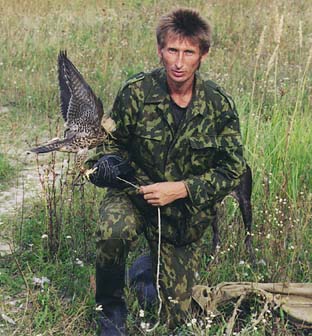
photos by author;
drawing by R. Sorish;
Translation into English: Yevheniia Mikheenko
Peregrine
(Falco peregrinus)
 |
Mykola
Rud' photos by author; drawing by R. Sorish; Translation into English: Yevheniia Mikheenko |
A characteristic representative of the larger, 'true' falcons,
the Peregrine is often called the
wandering falcon - the adjective of its Bulgarian name, sokol
skitnik, literally means 'wanderer',
as does the English word 'peregrine'.
The bird's name in Ukrainian and Russian languages, sapsan, is of
Kalmyk origin.
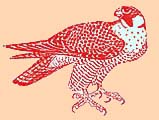 |
As a hunting bird, it is sometimes referred to as the 'duck hawk', 'game hawk' or 'great-footed hawk'. |
In the old Kyivan Rus the word 'falcon' – sokil – applied
solely to the Peregrine.
40 -50 cm in size, the falcon commonly weighs 600-1300 g, with
the females being
noticeably larger then males.
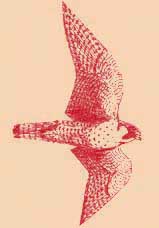 |
Among all the bird species on the planet, the Peregrine is capable of attaining the record speed of downward swoop – up to 300 km/h. In horizontal flight its typical speed is 100-110 km/h. |
Swift flight, high productivity and versatility in hunting
have determined
the Peregrine's popularity as a hunting bird in the countries of
Europe.
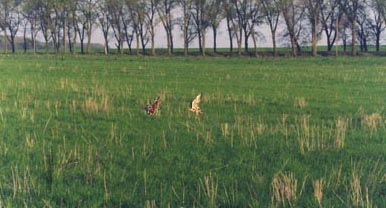
The pheasant does not have a chance against the swift predator.
Hunting with the Peregrine is the quickest, as well as the most effective. In the countries of the Middle East, where spectacular performance is prized above productiveness, connoisseurs of falconry liken the Peregrine to a rifle, due to its extraordinary speed in pursuit of prey. According to literary sources, a well-trained peregrine is capable of tackling the entire range of feathered prey up to the size of the Goose, and can be even cast at the Heron. An important characteristic of the falcon is that it is only able to take prey in mid-air, or, at most, from the treetops.
The well-known ornithologist Wolfgang Baumgart, comparing the capabilities of different falcons, notes that the Peregrine shows excellent results when flying at great height. Circling above the falconer, the peregrine ensures its ultimate advantage both in speed and orientation. High in the air, it instinctively assesses the wind velocity, and is able to anticipate potential movements of prey. On the contrary, the prey, taking to the air when roused by the dog or the hunter, loses both in speed and due to the lack of information about its immediate surroundings. Therefore, the circling falcon, specifically trained for hunting in this manner, can gain superb results and almost entirely avoid failures.
Practising falconers affirm that it is more difficult to train
the Peregrine than the Saker. Unlike the latter, the Peregrine
almost never forms strong attachment with its owner, and requires
constant control of feeding times and the calorie content of its
food. When well fed, the bird can easily leave its master,
preferring freedom to onerous friendship with Man.
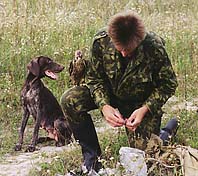 |
|
If fed too much, the falcon may abandon its owner, while in the latter case it soon weakens, loosing its hunting qualities. This is due to the fact that the Peregrine is a relatively small bird, and therefore has a higher level of metabolism than the Gyrfalcon or the Saker. In working with the Peregrine, the first and foremost rule of the falconer is strict regularity – it is also a sure way to avoid many problems of training, and to ensure stability of the bird's excellent hunting condition.
The Peregrine is unquestionably acclaimed by all the schools
of falconry as the most beautiful of falcons.
It is predominantly dark, with a greyish back and speckled underbelly plumage. Both sides of the head display a dark 'moustache', which is especially prominent in males. The Peregrine young are less brightly coloured and more speckled, with a reddish tinge on the underbelly. There are up to 20 sub-species of the Peregrine, with colour varying from almost white (Eurasian tundra) to red (India) and even black (Aleutian Islands). The spread of the species in nature is significant – it is present across every continent save the Antarctic, except for the plains of Northern America. In Ukraine, the Peregrine is a rare, settled species of the north-western regions (Poliss'a) and the Carpathian Mountains, although several nest pairs have also been observed in the forest-steppe regions. The Peregrine nests in forests across Europe and Asia up to the Himalayas. Generally, it is migratory in the northern parts of its inhabited regions, nomadic in the temperate zones and settled towards the south.
The individuals reach maturity and form pairs in the third year of life. A typical hatch consists of three eggs. In late July the hatchlings are still covered in white down, although in one and a half to two weeks they are fully feathered with the characteristic colouring, though some down still remains. A few days more and the young first take to wing. Through the period from hatching to final migration, it is fairly easy to tell the younger and older fledglings apart by sight. The older ones learn to fly first, and are for a long time noticeably larger and heavier than their younger siblings. With appearance of a human by the nest, the birds show signs of aggressiveness: closer than 150 m – and the falcons give warning calls, imitate swooping attack, and are potentially very dangerous.
The birds winter in Northern Africa, India or in the countries of Mediterranean. In warm winters, lone wandering individuals can be seen by cities where there is sufficient prey such as doves, jackdaws or sparrows. In the wild, the Peregrine usually preys only on the middle-sized birds: doves, gulls, crows, etc. When feeding nestlings the male, having to provide for the female and its young, will also hunt smaller species such as the Stilt or the Sparrow. Occasionally the Peregrine has been observed to hunt rodents – however, this is an exception dictated by demands of survival rather than the rule.
The Peregrine is the species best suited for keeping in cities with the aim to control populations of crows, jackdaws, rooks or doves, as the Peregrine can successfully counter organised defences or attacks of mixed flocks, usually led by the hooded crows.
The Peregrine is registered in the Red List of the International Union for the Conservation of Nature and in the Red Books of many other countries, as an endangered species requiring special protection. Unfortunately, to date there is little data about the numbers of the Peregrine in the wild even in specialist literature. In Moscow region the falcon was last observed in 1967. In 1996, seven young peregrines were brought to Moscow in the hope of restoring the species. The dynamic of the Peregrine population in Europe is still uncertain. In 1974 ornithologists did not register any individuals on the territory of former German Democratic Republic. However, in 1988 seven nesting pairs with hatches were observed in the area. It is almost impossible to find regular and reliable data updates for the population numbers of a species with such an extensive habitat. However, the numbers are declining in the northern regions such as parts of the Russian Federation. At the beginning of 1970s the count of nesting pairs on the whole territory of USA, from the east to the west coast, just exceeded a thousand. However, due to misuse of DDT, only 6 pairs remained in the Colorado state, and 20 in California, by 1973.
An original strategy for increasing the Peregrine population was developed in USA in 1988. Eggs were collected from wild nests at the early stages of incubation and replaced with similar-coloured plastic copies. The chicks were hatched in artificial incubators and, at three weeks old, returned to the nests at a convenient opportunity. In this way, the natural losses during the incubation period were avoided. However, this strategy could only be implemented in the regions where at least a small population remained. In the areas where the species had disappeared, artificially bred fledglings were deposited in cages on high ground out of sight of human settlement, and fed for several days through special 'sleeves'. Gradually, the birds were tempted out of the cages by food that was placed close by and still moving, and soon left to their own instincts. In this way, nearly five thousand young were released into the wild since 1978. In the vast regions east of Mississippi, where up to 1975 the Peregrine population had disappeared, more than a hundred nesting pairs were observed after two decades of the restoration project. The programme, which had cost over 30 million US dollars, was crowned with success after the Peregrine was taken off the register of species under threat of extinction. Now, there is widespread effort in the European countries to artificially breed a hybrid of the Peregrine and the Gyrfalcon, as it would be the most suited to the demands of hunting in varied landscapes and climates.
The breeders aim to retain the Peregrine's swiftness of flight
and excellent manoeuvrability. Projects like these supply the
practising falconers with physiologically fit hunting birds, and
thus lower the market demand for falcons from the wild, which is
hoped to slow down the population decline.
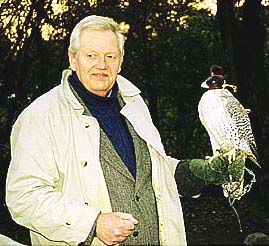 |
Among the specialists of
hybrid falcon breeding whose projects have been
successful is the Austrian falconer Karl Puchberger, who
has created a quality parent stock of falcons and
developed an original system of selective breeding, with superb results. |
Such beneficial strategies can supply the annual demand for birds of prey in excellent condition, which will not be taken from the wild, endangered during the long-distance transportation, or maimed by inexpert tactics of smugglers or at the cruel hands of poachers.
The artificially bred birds could be lawfully
sold to any falconer possessing an adequate qualification and
wishing to hunt with a bird of prey, who would be able to take
them into any country.
(C) Ukrainian
magazine"Naturalist"
